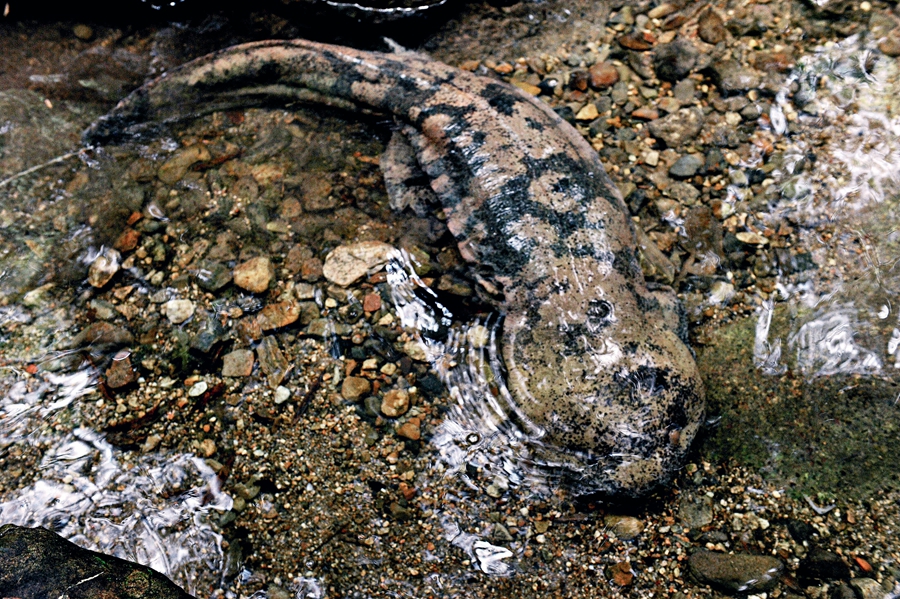Chinese Giant Salamander
China Today,May 28, 2018 Adjust font size:
In the mountain streams and rivers in the middle and lower reaches of the Yangtze River, the Yellow River, and the Pearl River in China, there lives a kind of unique amphibian – the Chinese giant salamander (Andrias davidianus). With short and flat webbed limbs, this amphibian has short forearms resembling those of a child, and similarly enough, sounds like a wailing infant.
Biologists believe that the giant salamander originated around 350 million years ago, existing around the same period as the dinosaurs. Due to the duration of its existence, it is also referred to as a “living fossil”.
In 2002, archaeologists discovered a 165-million-year-old zoolite in the Jurassic era strata of Ningcheng County of China’s Inner Mongolia Autonomous Region, which is believed to be the ancestor of the giant salamander. Today’s giant salamanders are generally about 60-70 cm in length and weigh about 5-6 kg. In Hunan Province, a salamander with a length of 2.1 meters and a weight of 65 kg was captured. Archaeologists believe that their ancestors were much larger than the salamanders of today.
Some ancient Chinese books about 2,000 years ago recorded that “the giant salamander has four legs; lives like a softshell turtle and moves quickly by use of its limbs, looks similar to fish, and sounds like a wailing infant.” The body is divided into the head, trunk, limbs, and tail. Its head is flat and blunt, with a large mouth, and underdeveloped eyes without eyelids. The front part of the body is flat, gradually curving to form the tail, with fins on both sides. The salamander’s body features wrinkly skin, with five fingers on the upper limb and four on the lower, separated with slight webbing to help them in the water. The skin on the body surface is relatively smooth, with small pods that secrete white, pulp-like peppery mucus upon stimulation. A giant salamander can adapt the color of its body depending on the environment where it lives. Its natural skin tone is usually brown, reddish brown, or dark brown, and the belly is light brown or grayish white.
It has vestigial lungs, so it is similar to a frog, using moist skin to exchange gas as an assisted form of breathing. From the viewpoint of biological evolution, this occurs when a species, such as fish, transitions from living in the water to true land based creatures.
Giant salamanders typically live in mountain streams due to their cool and rapid flows, and numerous crevices and caves. When not in the water, these creatures sometimes move by crawling on tree roots or on fallen tree trunks. Giant salamanders’ dens are generally close to water bodies, and usually only one giant salamander lives in each den. These amphibians require the water temperature to be between 0°C and 26°C. If the water temperature is too high, it will choose to sleep during the summer; when it is too low, it will also reduce activities, and even hibernate until the spring.
Giant salamanders often hide in dens during the day, with their heads facing outwards, always ready for action, such as scouting for food or hiding from enemies. If they spot danger, they flee the den and swim deep into the water. Activities and predation usually occur during the evening. Giant salamanders like to eat fish, frogs, crabs, snakes, shrimps, earthworms, and aquatic insects. Sometimes they also eat birds and rodents.
Despite their appearance, these creatures can be quite ferocious when hunting, waiting quietly behind the rocks in the stream for their ideal moment to strike. When the prey passes by, the giant salamander suddenly launches an attack. Due to its sharp and dense teeth, the prey usually dies quickly after the salamander gets ahold of it. Due to the slow metabolism, it is very resistant to hunger when there is a lack of food, and can often go for two to three years without eating. Their lifetime is long and they can generally live for 50 to 60 years, or even up to 130 years.


